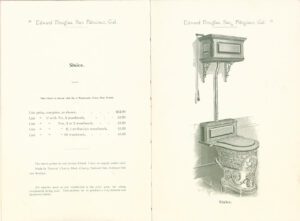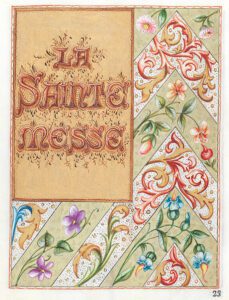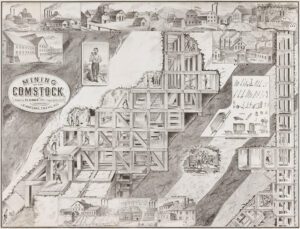New Additions to the Collection
The Foundation ensures the California State Library can continue to update and expand services and products to connect patrons with California’s past, present, and future. Below are examples of fascinating material that we acquired on behalf of the Library’s California History Section.
Become a member to keep up to date on our latest projects and publications for the Library.
1916 the Bartenders Union Grand Ball
In April 1916, the Bartenders Union in Los Angeles held a grand ball and issued a fascinating program to celebrate the event. While the program is filled with advertisements for bars and liquor stores, the big issue of the day was prohibition. One of the pages is titled: “A Few Reasons Why You Should Vote Against Prohibition.” Naturally, it focused on the thousands of bartender jobs that would be lost in California and told of the hardships faced in Colorado, Washington, Oregon and Arizona as a result of prohibition. The two-column editorial also railed against the “Moral Fanatics” arguing that unemployment leads to higher crime rates, general immorality, and alcoholism.
The California History Section has a fabulous collection of early trade catalogs issued by a variety of California businesses ranging from hardware stores to haberdashers. A fascinating new example is the 1893 Illustrated Catalogue of Sanitary Specialties of the Edward Douglas Company of San Francisco. The catalog is illustrated with line drawings of the “noiseless” water closet (toilets) tanks and wood seats. However, it is amazing the elegance of the bowls that came with the tanks and seats, many of which carried carved or molded ornamental embellishments carrying such names as “Lakeside,” “Clydesdale,” “Pearl,” “Eagle,” and “Sluice.” For the seats and tanks, customers could select from a variety of woods including natural cherry, dark cherry, natural oak, antique oak, and walnut. Shown here is the “Sluice.” Depending on the selection of wood, prices ranged from $43 to $52.
A French Illuminated Wedding Book
The Sutro Library’s Richard F. Larson Trust has enabled the acquisition of two spectacular works. The first, a French manuscript Book of Hours, dates from May 1905 and was created for the wedding of Pierre Claudio Jannet and Reneé Marie Jane Albert Bordeau Montreux. Consisting of seventy-seven pages, it is a superb example of an early twentieth century emulation of a medieval manuscript. Written on vellum (sheepskin) leaves, the morocco-bound (goatskin) wedding book includes the text of the wedding ceremony and wedding mass, all in Latin. Each of the seventy-seven pages features a unique hand-painted decorated border, illuminated with many gold highlights. The borders include animal or floral patterns, landscapes, and various geometrical patterns. Each page is a work of art and complements the illuminated manuscripts acquired by Adolph Sutro in the 1880s.
Support Cultural Education
The California State Library Foundation needs your help to protect the Library’s culturally essential services and vast collection containing millions of artifacts. While the library does receive funding from the state and federal government, ever-increasing competition for those funds means looking beyond tax revenue to accomplish objectives. You can make a difference!
A Spectacular Binding and Fore-edge Painting
Thomas Roscoe’s Wanderings and Excursions in North Wales, (London: C. Tilt, Simpkin and Company, ca. 1837) is another recent addition made possible by the Larson Trust. Besides the lively text, this two-volume work stands out for two reasons: its breathtaking binding and the watercolor paintings on the fore-edges (outer edges the book). Roscoe’s books of travel adventures in Wales were bound by the distinguished Liverpool firm of Fazakerley. Fazakerley further embellished the fore-edges of each volume with a triptych of watercolor paintings of Snowdon, Carnarvon, and Menai Bridge in North Wales; and Carmarthe, the Mumbles, and Tintern Abbey in South Wales. The treatment of the fore-edges was a specialty of the firm founded by Thomas Fazakerley around 1835. He was succeeded by his son, John, who ran the business until the beginning of World War I.
Lithograph, Mining on the Comstock
Mining on the Comstock is a detailed 24 x 34 inch lithograph from an 1876 drawing by T. L. Dawes published in 1877. The print renders in detail the amazing inner workings of a Comstock mine in northwest Nevada. The mines were the basis of Adolph Sutro’s fortune. One of the many challenges facing Comstock mining engineers was the instability of the ore bodies and the risk of a cave-in. The traditional method of strengthening tunnels with “post and cap” timbers proved too dangerous resulting in tunnel collapses and the deaths of many miners. The illustration shows German engineer Philipp Deidesheimer’s ingenious safety development known as “square sets,” a system that enabled miners to reach great depths without fear of the earth collapsing around them. Additional details feature miners at work swinging picks, pushing ore carts, and constructing set cubes. On the far right, is a long vertical shaft where ore was hoisted to the surface. Because Comstock miners worked in tremendous heat a special chamber loaded with ice was devised so they could rest and cool off. Dawes’s illustration is further enhanced by a series of vignettes showing above ground works of various mining companies including the Gould and Curry, Ophir, Crown Point, and Consolidated Virginia.
Galen Clark Letter on Yosemite
Next year marks the 150th anniversary of President Abraham Lincoln signing a bill to create the Yosemite Grant, thereby protecting this magnificent valley. One of the noted early guardians of Yosemite was Galen Clark (1814–1910). Added to the California History Section’s manuscript holdings is this amazing letter by Clark to a Mr. Kelsey in New Hampshire dated September 17, 1903, summarizing his concerns for preserving the precious natural wonder. In the letter, Clark urges proper management of the landscape in view of the increasing number of visitors requiring more “comfortable” accommodations. He advocated the park’s return to federal control, rather than leave it in “the hands of hands of politicians” whom he accused of mismanagement. He cited several accidental fires in and around Yosemite Valley which necessitated considerable clearing of brush and dense undergrowth.“This is a work which requires good judgment and foresight as to future appearance. It is not every expert wielder of the ruthless exterminating ax who is also a skillful delineator of artistic landscape scenery.”
Arnold Genthe Portraits
Several new photographs and postcards have been added to the California History Section of the Library via the Foundation including a striking portrait of Elsie Whitaker Martinez (1890–1984) by the famed photographer Arnold Genthe. The daughter of English writer Herman “Jim” Whitaker, Elsie moved with her family from England to Oakland in 1895. Whitaker, friend and contemporary of Jack London, enjoyed a wide circle of artistic and literary friends including the Mexican-born artist Xavier Martinez. Xavier met and fell in love with Elsie and the two were married on October 17, 1907. Photographer Genthe is best known for his photographs of San Francisco’s Chinatown and the 1906 Earthquake and Fire. Genthe was also a superb portrait photographer who used a signature soft-focus, dreamy style. The Library has an equally compelling signed photograph by Genthe of her husband, Xavier.















